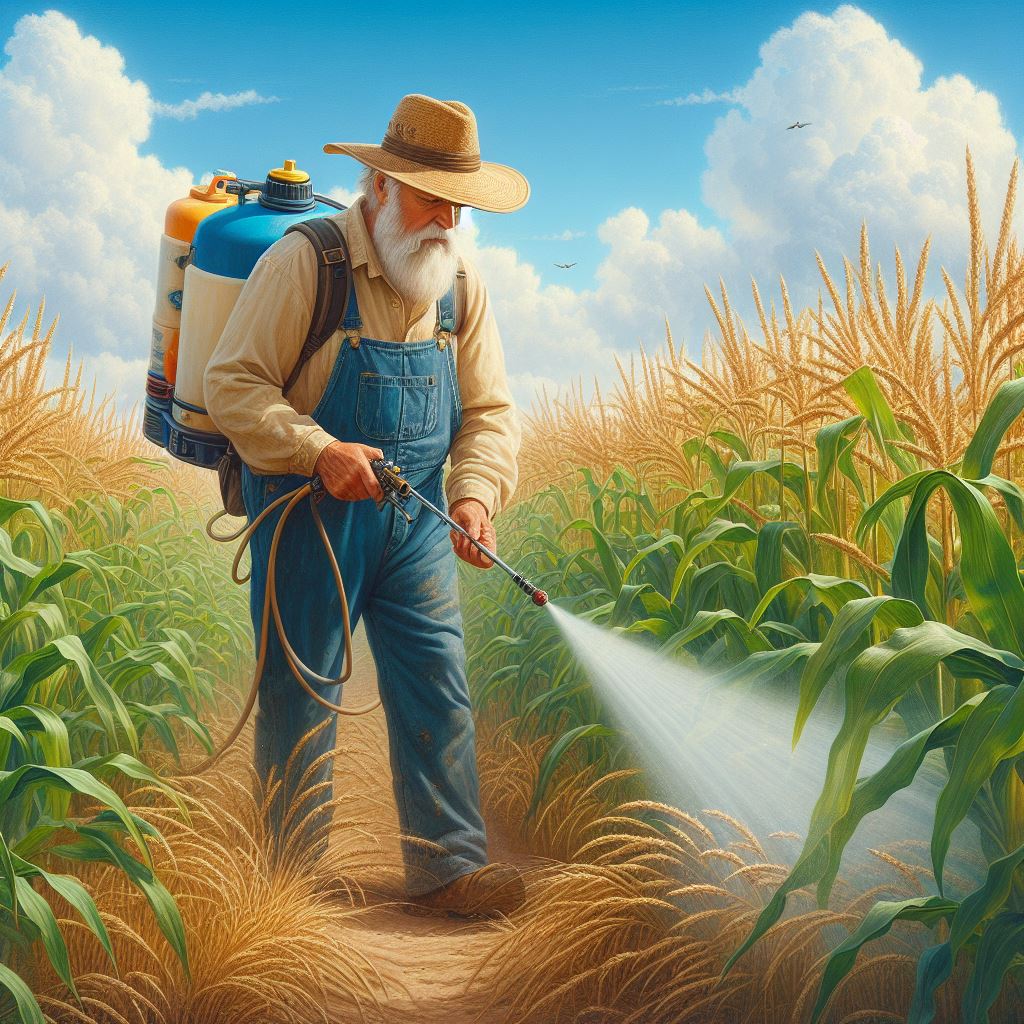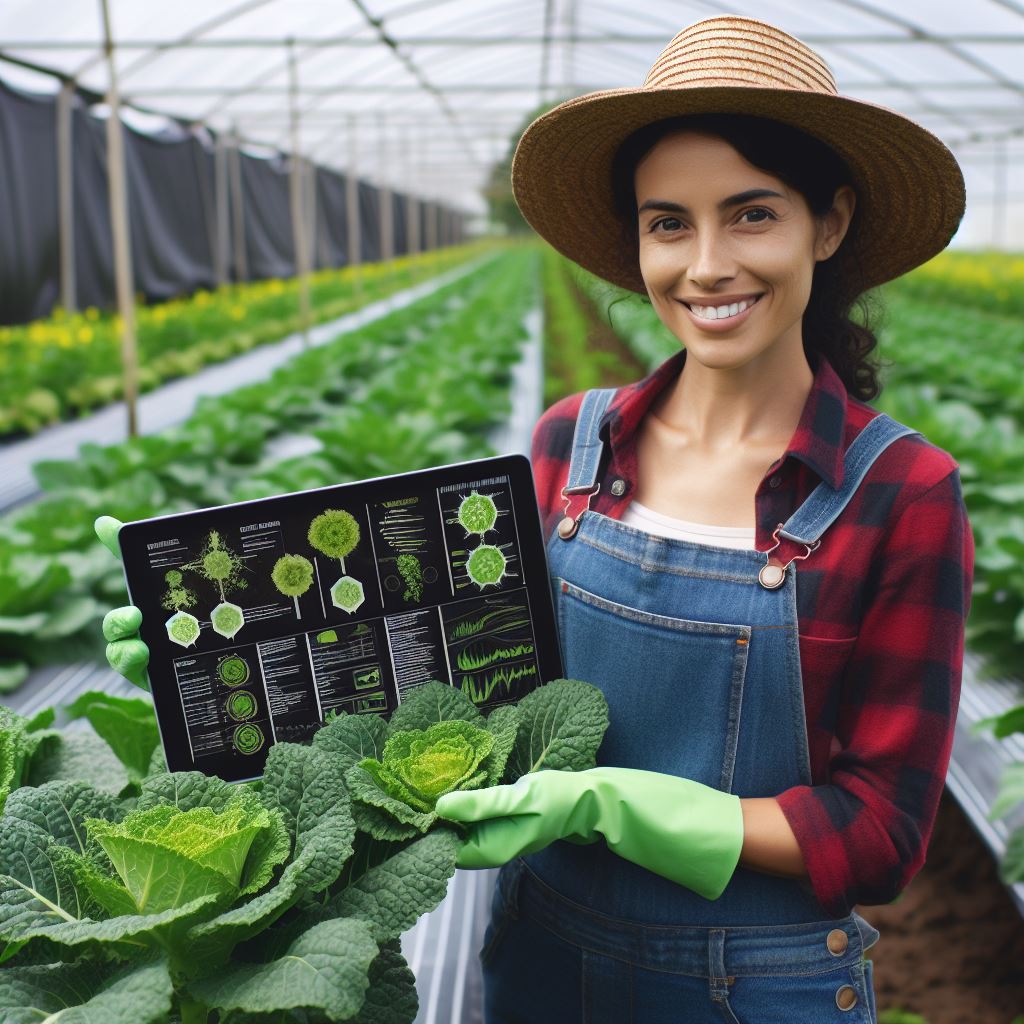Introduction
Droughts have become more frequent and intense, causing significant challenges for farmers. There is a solution – drought-tolerant crops.
These crops have the ability to withstand water scarcity and still produce high yields.
In this blog post, we will explore the importance of drought-tolerant crops for farmers and provide a comprehensive guide on how to incorporate them into farming practices.
Droughts can have devastating effects on crop production, leading to lower yields and financial losses for farmers.
By cultivating drought-tolerant crops, farmers can mitigate these risks and ensure a stable food supply.
These crops are specifically bred to thrive in arid conditions, requiring less water while maintaining productivity.
They provide resilience and adaptability to changing climate patterns, making them a valuable asset for farmers facing water scarcity.
The purpose of this blog post is to educate farmers on the benefits and cultivation techniques of drought-tolerant crops.
By sharing practical knowledge and insights, we aim to empower farmers to make informed decisions and successfully incorporate these crops into their farming systems.
Through this blog post, we hope to inspire farmers to adopt sustainable and climate-smart practices to mitigate the impacts of droughts and ensure food security.
In fact, drought-tolerant crops play a vital role in agricultural sustainability and resilience in the face of water scarcity.
By embracing these crops and implementing the techniques discussed in this blog post, farmers can minimize the risks associated with droughts and ensure a prosperous future for their farms.
Stay tuned for the next sections where we will delve deeper into the selection and cultivation of specific drought-tolerant crops.
Understanding Drought and Its Impact on Agriculture
A. Definition of drought
Understanding drought and its impact on agriculture is essential for farmers to cope with its challenges.
Drought, defined as a prolonged period of abnormally low rainfall, has severe consequences for crops.
Transform Your Agribusiness
Unlock your farm's potential with expert advice tailored to your needs. Get actionable steps that drive real results.
Get StartedThe effects of drought on crops can be devastating, leading to reduced yields and even crop failure.
This, in turn, has significant economic implications for farmers.
Drought, simply put, is a prolonged period of extremely low rainfall, often resulting in water scarcity.
It is a natural climate phenomenon that can occur in any region, affecting agriculture globally.
When rainfall is insufficient, crops suffer from water stress, limiting their growth and productivity.
Understanding the definition of drought enables farmers to recognize its signs and take necessary actions.
B. Effects of drought on crops
The effects of drought on crops are multifaceted and far-reaching.
Firstly, drought reduces the availability of water for irrigation, making it more challenging to maintain crop health.
Without sufficient water, plants are unable to carry out essential biological processes, hindering their growth and reducing their overall quality.
Secondly, drought weakens crops and makes them more susceptible to pests and diseases.
Stressed plants become more vulnerable, decreasing their ability to defend against harmful organisms.
This further exacerbates crop losses caused by drought.
C. Economic implications of drought for farmers
The economic implications of drought for farmers are significant and can be catastrophic.
- Reduced crop yields directly impact the income and livelihoods of farmers, as they rely heavily on their produce for financial stability.
- Decreased yields mean less product to sell, resulting in lower profits.
- Additionally, drought-induced crop failures can lead to substantial financial losses.
- Farmers not only suffer immediate financial setbacks but also face long-term consequences, such as increased debts and reduced ability to invest in future farming activities.
- Furthermore, drought can disrupt the local and regional economy.
- Agriculture plays a vital role in many communities, providing employment opportunities and contributing to the local economy.
- When crops fail due to drought, farmers may experience a decline in income, forcing them to reduce spending on goods and services.
- This ripple effect can negatively impact various industries, including food processing, packaging, and transportation.
- The entire supply chain can suffer, leading to job losses and economic downturns in the region.
To combat drought, farmers use strategies like efficient irrigation and drought-tolerant crops, enhancing resilience.
Understanding drought’s impact is crucial for successful navigation.
Drought, with prolonged low rainfall, harms crops, causing yield reduction and economic losses.
Farmers can mitigate drought impact through proper strategies, ensuring agricultural sustainability.
Addressing drought effects secures farmers’ livelihoods and agricultural stability.
Despite the potential devastation, growing drought-tolerant crops helps mitigate risks and ensure farmers’ livelihoods.
Read: Climate-Smart Soil Health: Key Strategies
Benefits of Growing Drought-Tolerant Crops
A. Increased resilience to drought conditions
Drought-tolerant crops have the ability to withstand and adapt to limited water availability.
They are genetically modified or bred to be more efficient in their water usage and can survive in drought-prone areas.
By growing these crops, farmers can better cope with water scarcity during drought periods.
B. Higher chances of crop survival
- Traditional crops are vulnerable to water stress, causing them to wither and ultimately die during droughts.
- However, drought-tolerant crops have specialized mechanisms that allow them to continue growing even when water is limited.
- This increases the probability of crop survival, reducing the risk of complete crop failure.
C. Improved farm profitability
- Growing drought-tolerant crops can lead to enhanced farm profitability.
- Farmers who invest in these crops can maintain productivity even in drought conditions.
- The availability of a harvest despite water scarcity ensures a steady income stream, minimizing financial losses.
- Additionally, the demand for drought-tolerant crops tends to be higher due to their resilience, leading to higher market prices.
In summary, the benefits of growing drought-tolerant crops for farmers are numerous.
Showcase Your Farming Business
Publish your professional farming services profile on our blog for a one-time fee of $200 and reach a dedicated audience of farmers and agribusiness owners.
Publish Your ProfileThey offer increased resilience to drought conditions, higher chances of crop survival, improved profitability, reduced water usage, soil conservation, reduced dependency on irrigation, and adaptability to climate change.
Investing in the cultivation of these crops not only ensures the survival and productivity of farms but also contributes to sustainable agriculture and the mitigation of water scarcity challenges posed by drought.
Read: Onion Storage Tips Post-Harvest
Popular Drought-Tolerant Crop Options
When it comes to farming in areas prone to drought, choosing the right crops is crucial.
Fortunately, there are several popular drought-tolerant options that can help farmers maintain their productivity even in challenging conditions.
In this section, we will explore three such crops: maize, sorghum, and pearl millet.
A. Maize
Maize, also known as corn, is a widely grown crop with excellent drought tolerance.
It is known for its adaptability and ability to produce good yields even in arid regions.
Maize has deep root systems that allow it to access water from lower soil layers, making it resilient to drought.
To cultivate maize in drought-prone areas, farmers should follow some best practices. Firstly, selecting drought-tolerant maize varieties is essential.
These varieties are specifically bred to withstand water scarcity and have traits like shorter maturity periods.
Additionally, planting maize in well-prepared soil with good drainage is important.
Using proper irrigation techniques and timed watering can further optimize water usage.
B. Sorghum
Sorghum is another popular choice for farmers dealing with drought conditions.
It is a versatile crop that can tolerate a wide range of environmental stress, including limited water availability.
Sorghum’s deep and fibrous root system allows it to efficiently extract water from the soil.
For successful sorghum cultivation, farmers should employ certain best practices.
Firstly, it’s important to choose a suitable variety of sorghum that demonstrates high drought tolerance.
Planting sorghum in well-prepared soil with good organic matter content helps with water retention.
Farmers should consider conservation tillage techniques to reduce water loss from evaporation.
Efficient irrigation methods like drip irrigation or furrow irrigation can also help maximize water use.
C. Pearl Millet
- Pearl millet is a hardy and resilient crop highly adapted to arid and semiarid regions. It has a robust root system that enables it to endure water stress for extended periods.
- Pearl millet can produce reasonable yields even with limited rainfall.
- When cultivating pearl millet in drought-prone areas, farmers should follow specific best practices.
- Firstly, selecting the right variety of pearl millet that exhibits strong drought tolerance traits is crucial.
- Planting pearl millet in well-drained soil enriched with organic matter can enhance its water-holding capacity.
- Farmers should consider utilizing mulching techniques to conserve soil moisture.
- Implementing rainwater harvesting strategies can also be beneficial in maximizing water availability.
In short, when faced with drought conditions, farmers can rely on drought-tolerant crops like maize, sorghum, and pearl millet.
By selecting suitable varieties and adopting best cultivation practices, farmers can increase their chances of success even in unfavorable climate circumstances.
These resilient crops offer hope and the opportunity for sustainable farming in drought-prone regions.
Read: Carrot Harvest: Getting Timing Right

Techniques for Successful Cultivation of Drought-Tolerant Crops
A. Water management strategies
- Monitor soil moisture levels regularly using moisture meters or visual inspection techniques.
- Implement a water management plan that includes scheduling irrigation based on crop needs.
- Use efficient irrigation techniques, such as drip irrigation or pivot systems, to minimize water wastage.
- Practice deficit irrigation, where water is applied strategically to meet the minimum crop requirements.
- Implement rainwater harvesting methods to capture and store rainfall for later use.
B. Efficient irrigation techniques
- Drip irrigation delivers water directly to the roots, minimizing evaporation and water loss.
- Sprinkler irrigation can be modified to reduce evaporation by applying water during cooler periods.
- Micro-irrigation systems ensure precise water application, targeting the root zone of each plant.
- Subsurface irrigation delivers water underground, minimizing evaporative losses and reducing weed growth.
- Smart irrigation controllers use weather data and soil moisture sensors to optimize water application.
C. Rainwater harvesting methods
- Install rain barrels or cisterns to collect and store rainwater for future irrigation needs.
- Construct rooftop rainwater harvesting systems to capture rain directly from roofs.
- Use contour bunding or terracing to capture rainwater and prevent runoff on sloping fields.
- Implement check dams or swales to slow down and store rainwater in larger catchment areas.
- Utilize underground storage tanks to store collected rainwater for long-term use during dry periods.
D. Soil preparation and conservation practices
- Conduct soil tests to determine nutrient deficiencies and pH levels for proper crop growth.
- Perform deep tillage to break up compacted soil and improve root penetration and water infiltration.
- Use cover crops to protect the soil surface, reduce evaporation, and improve soil fertility.
- Implement contour plowing to minimize water runoff and erosion on sloping fields.
- Practice crop residue management to retain moisture, suppress weeds, and improve soil structure.
E. Crop rotation and diversification
- Rotate different crop species to alleviate stress on the soil and prevent the buildup of pests and diseases.
- Include leguminous crops in rotation to fix atmospheric nitrogen and improve soil fertility.
- Diversify crop varieties to spread risk and optimize yields under varying climatic conditions.
- Integrate livestock into cropping systems to recycle nutrients and enhance soil health.
- Incorporate agroforestry practices to enhance soil moisture retention and provide additional income streams.
Resources and Technologies for Farmers
A. Government Programs and Schemes for Promoting Drought-Tolerant Crops
- Subsidies and financial assistance from the government can encourage farmers to adopt drought-tolerant crop cultivation practices.
- Creation of agricultural insurance schemes specifically tailored to cover losses due to drought can provide a safety net for farmers.
- Provision of technical support and extension services by the government can educate farmers about the benefits of drought-tolerant crops.
- Implementation of water management projects, such as construction of check dams and water reservoirs, can enhance water availability for agriculture.
- Development of market linkages and promotion of value-addition activities can enable farmers to fetch higher prices for their drought-tolerant crops.
- Collaboration between the government and research institutions can facilitate the dissemination of improved crop varieties suitable for drought conditions.
- Subsidized distribution of drought-resistant seeds, fertilizers, and pesticides can reduce the financial burden on farmers.
- Government initiatives to establish farmers’ cooperatives can provide collective bargaining power and enable resource-sharing among farmers.
- Introduction of agricultural credit schemes with flexible repayment options can enable farmers to invest in drought-tolerant crops.
- Policy backing and regulatory frameworks, focusing on land rights and water access, can motivate farmers to embrace drought-tolerant crop cultivation.
B. Research Institutions and Agricultural Experts
- Research institutions play a crucial role in developing improved crop varieties and technologies for drought-prone areas.
- Agricultural experts provide guidance and knowledge to farmers about the selection and cultivation of drought-tolerant crops.
- Research on crop physiology and genetics helps in understanding the mechanisms behind drought tolerance, leading to targeted breeding efforts.
- Agronomists and soil scientists offer expertise in soil management practices, enabling farmers to optimize water and nutrient use.
- Collaboration between research institutions and farmers facilitates the on-ground testing and validation of new drought-tolerant crop varieties.
- Continuous research and development efforts by agricultural experts contribute to the advancement of farming practices for drought resilience.
- Extension services provided by agricultural experts help disseminate research findings and best practices to farmers.
- Farmer-centric research collaborations enable the identification of region-specific challenges and the development of tailored solutions.
- Training programs conducted by agricultural experts equip farmers with the skills to implement innovative farming techniques and technologies.
- The knowledge shared by agricultural experts contributes to the overall growth and sustainability of the farming community.
C. Access to Improved Crop Varieties and Hybrids
- Seed companies play a crucial role in providing farmers with access to improved drought-tolerant crop varieties and hybrids.
- Plant breeders continuously develop and introduce new crop varieties with enhanced drought tolerance traits.
- Availability of certified seeds from trusted sources ensures the authenticity and quality of drought-resistant crop varieties.
- Seed banks and gene banks preserve and provide access to diverse genetic resources that can be utilized for breeding drought-tolerant crops.
- Collaboration between seed companies, research institutions, and farmers enables the identification and distribution of suitable crop varieties.
- Demonstration plots and field trials help farmers evaluate the performance of different crop varieties under drought conditions.
- Public-private partnerships promote the commercialization and accessibility of improved drought-tolerant crop varieties.
- Seed subsidy programs and seed vouchers empower farmers to procure quality seeds at subsidized rates, promoting the adoption of drought-resistant crops.
- Farmer-exchange programs facilitate knowledge sharing and the exchange of seeds to enhance genetic diversity and resilience.
- The continuous availability of improved crop varieties and hybrids ensures that farmers have options to adapt to changing climate conditions and mitigate the impact of drought.
Challenges and Considerations
In the agricultural industry, farmers are constantly faced with challenges and considerations when it comes to cultivating and growing drought-tolerant crops.
These crops have become increasingly important as climate change brings about unpredictable weather patterns and extended periods of drought.
However, before farmers embark on growing drought-tolerant crops, there are several key factors that need to be carefully considered.
A. Initial Investment and Costs
Switching from traditional crops to drought-tolerant varieties requires a significant initial investment.
Farmers need to purchase new seeds, equipment, and irrigation systems specially designed for arid conditions.
Additionally, they may need to invest in upgrading their soil management practices to ensure optimal crop growth in drought-prone areas.
All these costs need to be carefully evaluated to determine the feasibility of transitioning to drought-tolerant crops.
B. Market Demand and Profitability
Farmers need to assess the market demand for drought-tolerant crops in their region.
Are there enough buyers who are willing to pay a premium for these crops?
Understanding the market dynamics is crucial to ensure profitability.
It is essential to research and identify potential buyers, such as restaurants, grocery stores, and food processors, who prioritize sustainable and resilient agriculture.
Moreover, analyzing the potential competition and pricing strategies can help farmers make informed decisions about crop selection.
C. Climate Variability and Future Predictions
- Drought-tolerant crops are specifically cultivated to withstand prolonged periods of water scarcity.
- However, climate variability remains a significant concern.
- Farmers must closely monitor weather patterns and predictions to determine the long-term sustainability of their chosen crops.
- Reviewing climate data and consulting local experts informs the feasibility of cultivating drought-tolerant crops in a specific region.
- Farmers should also consider any potential changes in future climate projections.
- Climate models predict alterations in temperature, precipitation patterns, and the frequency of extreme weather events.
- Evaluating these projections will assist farmers in preparing for potential challenges and adapting their farming practices accordingly.
- It may be necessary to switch to different drought-tolerant crop varieties if the projected climate conditions are not suitable for the initially chosen crops.
In essence, the cultivation of drought-tolerant crops presents farmers with various challenges and considerations.
The initial investment and costs, market demand and profitability, as well as climate variability and future predictions, all play significant roles in the decision-making process.
Being aware of these factors enables farmers to make informed choices and improve their chances of successful and sustainable farming practices.
Showcase Your Farming Business
Publish your professional farming services profile on our blog for a one-time fee of $200 and reach a dedicated audience of farmers and agribusiness owners.
Publish Your ProfileBy carefully assessing the risks and rewards associated with growing drought-tolerant crops, farmers can contribute to building a more resilient and adaptive agricultural system for the future.
Read: Pumpkin Picking: Perfect Timing Tips
Gain More Insights: Guidelines for Weed Control in Crops
Conclusion
Drought-tolerant crops are crucial for farmers in combating the challenges of water scarcity.
They offer resilience and stability to agricultural practices.
It is imperative for farmers to explore and adopt these crops to ensure sustainable farming in the face of climate change.
By integrating drought-tolerant crops into their agricultural systems, farmers can minimize yield losses and increase their profitability.
Furthermore, these crops can contribute to food security, poverty alleviation, and overall environmental sustainability.
Ultimately, the adoption of drought-tolerant crops is a step towards building a resilient and sustainable agricultural sector that can thrive even in the face of water scarcity.




